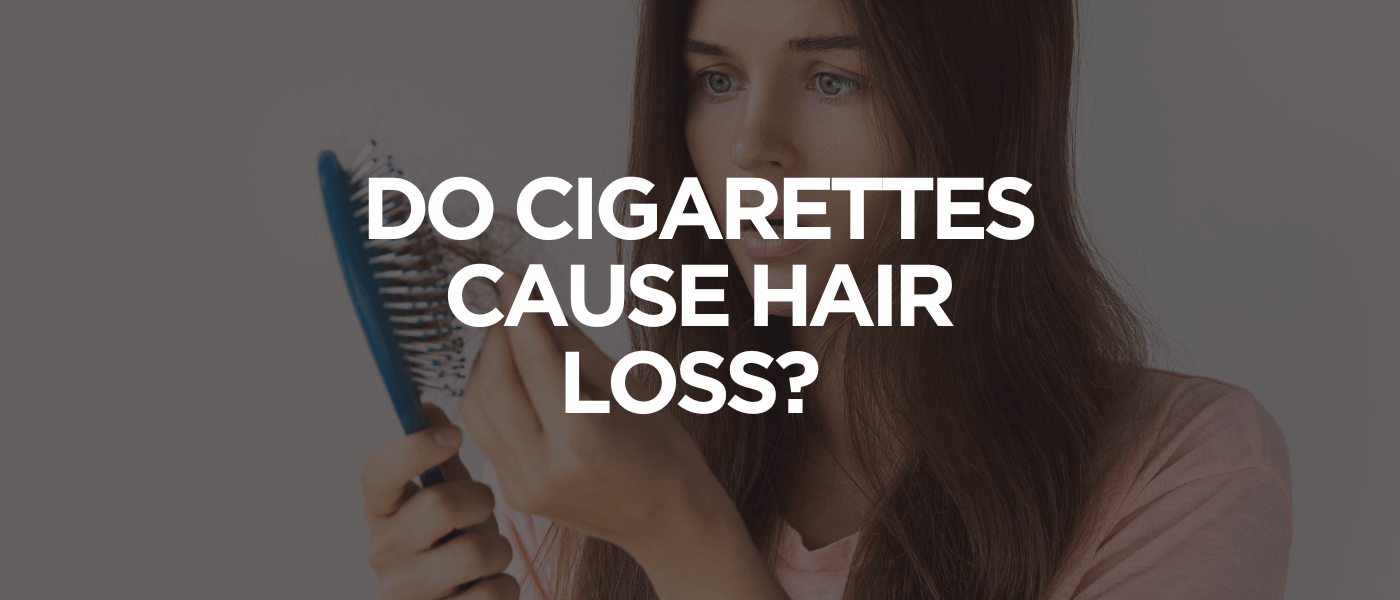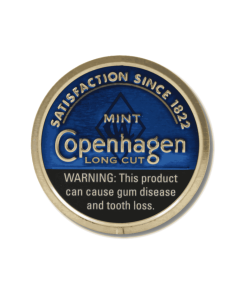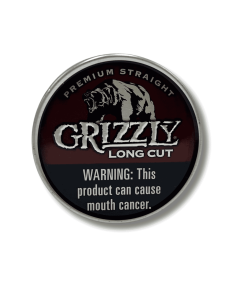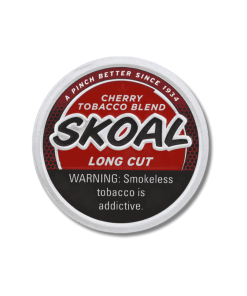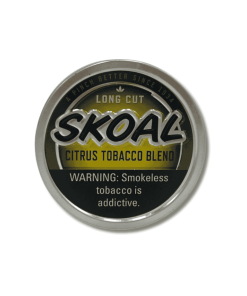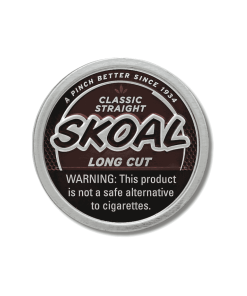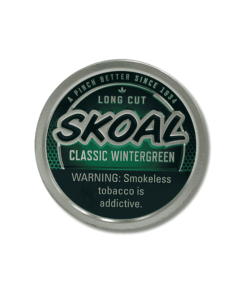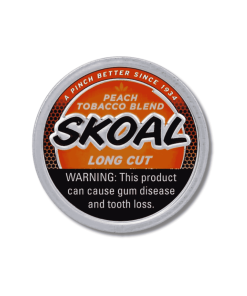Cigarettes, Health
Do Cigarettes Cause Hair Loss?
For decades, cigarette smoking has been the go-to activity of individuals who want to savour the hits coming from the said tobacco products. When you smoke a cigarette, it produces tobacco smoke, which contains nicotine and all other chemicals that enter your body through your lungs.
The direct inhalation of these chemicals, unfortunately, makes cigarettes harmful, especially when you smoke them regularly for a long time. In the last few decades, different medical studies and research have found a correlation between smoking and a number of health effects, particularly on one’s respiratory and cardiovascular systems.
One emerging fact, however, regarding cigarettes is their link to hair loss. Do cigarettes cause hair loss? How does cigarette smoking influence your hair growth? Native Smokes 4 Less is here to give you the truth about cigarette smoking and its impact on your hair health.
- Introduction to the Impact of Smoking on Hair
- The Effects of Smoking on the Hair Growth Cycle
- Damage to Hair Follicles
- Early Onset Androgenetic Alopecia
- Oxidative Stress and Hair Loss
- Hormonal Imbalances and Hair Loss
- Smoking-Related Hair Loss Conditions
- Quitting Smoking and Hair Regrowth
- Treatment Options for Hair Loss
- Preventing Hair Loss
- Frequently Asked Questions
- Summary
Introduction to the Impact of Smoking on Hair
One of the things you must know about cigarettes is they contain tobacco, a vital ingredient that naturally produces and releases nicotine. Once cigarettes undergo combustion, more cancer-causing chemicals are being produced, posing a number of health effects to one’s body.
Some of the common health risks associated with cigarette smoking include lung cancer, increased risk of heart attack and stroke, nicotine addiction and dependence, chronic respiratory conditions, and many more. Another health risk of smoking cigarettes is hair loss.
As mentioned earlier, the tobacco element of cigarettes can produce nicotine. Nicotine, in general, is a highly addictive substance that creates a temporary feeling of well-being and relaxation. It can, unfortunately, cause harm throughout the body, including your hair health.
A wide range of research notes that smoking cigarettes can somehow contribute to hair loss. The main reason behind this is the presence of harmful chemicals in cigarettes that directly affect hair follicles. When nicotine and other chemicals in cigarettes build up in hair follicles and the hair shaft, they can slowly start the process of hair loss and premature graying of the hair.
In a 2022 systematic review, it notes that cigarettes and their harmful chemicals can lead to hair loss due to the following mechanisms:
- Narrowing blood vessels: The nicotine and other chemicals coming from cigarettes could constrict your blood vessels, including the tiny capillaries that provide oxygen and nutrients to your hair follicles. When blood flow is reduced, hair follicles receive less nourishment and oxygen, which impedes their ability to grow strong, healthy hair. Over time, this compromised circulation can lead to weaker hair strands, slower hair growth, and eventual thinning hair or loss.
- DNA damage: Tobacco smoke from cigarettes contains carcinogens and toxins that can cause direct damage to cellular DNA, including those found in hair follicle cells. Damaged DNA disrupts the normal life cycle of the follicle, triggering premature cell death or malfunctioning follicle behaviour. This damage reduces the follicle’s ability to regenerate and grow new hair.
- Oxidative stress: Smoking cigarettes can increase the levels of free radicals or unstable molecules that damage cells in your body. This oxidative stress may overwhelm your body’s natural antioxidant defences and harm your hair follicle cells. This results in accelerated aging of the follicle, impaired function, and a higher chance of your hair entering the resting phase prematurely, leading to hair shedding and hair thinning.
- Inflammation: Chronic exposure to cigarette smoke promotes systemic inflammation throughout the body, including in the scalp and skin. Inflammatory responses around hair follicles can trigger miniaturization, disrupt normal hair cycles, and contribute to scarring in severe cases.
- Less sensitive neurotransmitter receptors: Nicotine typically interacts with neurotransmitters like dopamine and acetylcholine, and chronic use can desensitize them over time. This affects mood, stress responses, and hormonal balance, which are all closely linked to hair health. Disrupted neurochemical signalling can then impair the communication needed for healthy follicle cycling, potentially slowing down growth or triggering early shedding.
The same review found that the nicotine content of cigarettes can slowly narrow blood vessels, lowering the amount of blood flowing to the scalp. The same substance can cause inflammation of the hair follicles and make neurotransmitter receptors less sensitive, leading to hair follicle damage.
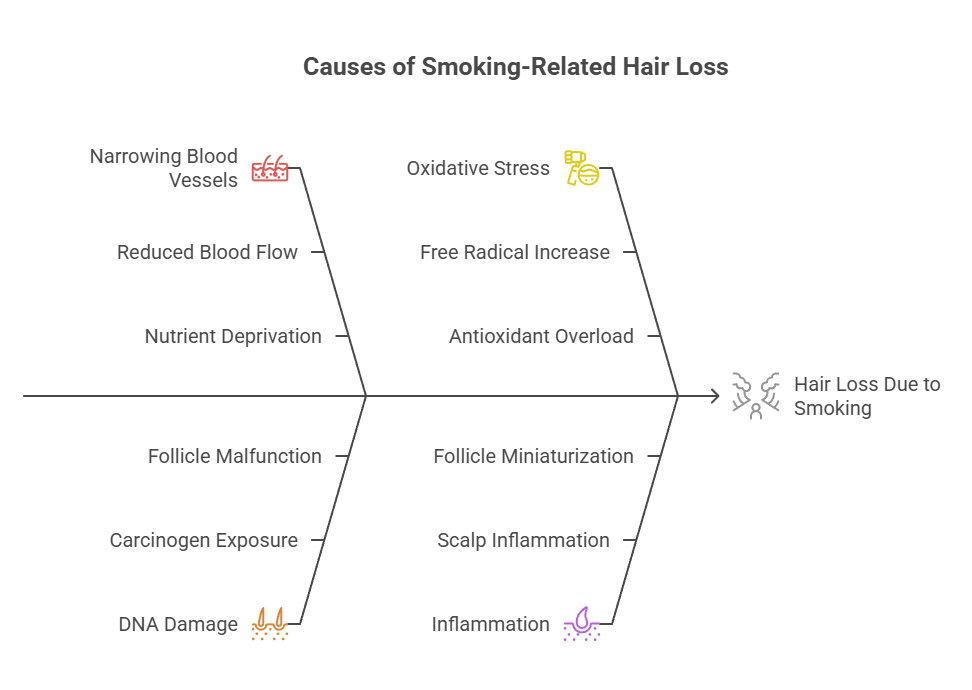
The Effects of Smoking on the Hair Growth Cycle
In 2018, a study showed that tobacco smoke, which is present in cigarettes, contains more than 7,000 chemicals, and at least 69 of them can cause cancer. As you breathe in these chemicals, they travel from your respiratory system to your bloodstream. From your blood, they can reach other parts of your body, negatively impacting many aspects of your health.
One of the side effects of smoking cigarettes, despite being less known, is an increased chance of developing hair loss. In particular, tobacco smoke can damage hair follicles through reduced blood flow, leading to various harmful effects on your hair health, including an interrupted hair growth cycle.
Hair follicles require oxygen, nutrients, and minerals to produce healthy hair. If toxic chemicals in cigarettes enter the bloodstream, they slowly shrink blood vessels and impede blood flow. Once the follicles don’t receive the blood they need for nourishment, the hair growth cycle, which consists of four phases (growth, transitional, resting, and shedding), is interrupted.
A recent study compared the prevalence of early-onset androgenetic alopecia or male pattern baldness or female pattern baldness in male smokers and non-smokers between 20 and 35 years old.
They found that 425 out of 500 smokers had some degree of hair loss, while only 200 out of 500 non-smokers showed signs of hair loss. They also found that 47% of the smokers had grade 3 hair loss (deep recession along the hairline) and 24% had grade 4 (vertex balding) on the Hamilton-Norwood scale of hair loss.
The researchers concluded that nicotine and other harmful chemicals from tobacco might be the main cause of accelerating hair loss. Despite the need for more studies, the fact that researchers have identified a trend regarding the effects of smoking on one’s hair health only means that it can truly lead to an interrupted hair growth cycle.
Damage to Hair Follicles
A hair follicle is a tube-like structure or pore that surrounds the root and strand of a hair. Often found in the top two layers of skin, it can stop functioning and then start working again to facilitate hair growth on your body. Out of the 5 million hair follicles in your body, one million are found on your head. As you age, hair grows out of these follicles.
So, what’s the function of a hair follicle?
In general, the main function of a hair follicle is to grow your hair. It also helps repair your skin after an injury or a wound, form new blood vessels, and create new nervous system neuron cells.
Now, hair follicles may only function optimally if they receive proper nutrients. If the blood flow to your scalp is impaired, your hair follicles may not function well, leading to hair loss or damage. Damage to hair follicles due to smoking cigarettes can also cause the following things:
- Weakened hair follicle structure: Tobacco smoke contains tons of harmful chemicals that can directly impair the structure and function of hair follicles. These toxins can interfere with the normal cell division process within the follicle, which makes it harder for healthy hair to grow. Over time, hair follicles become less productive, leading to thinner and weaker hair strands.
- Impaired hair growth cycle: As discussed earlier, hair follicles operate in a cycle (growing, transitional, resting, shedding). Smoking, unfortunately, disrupts this cycle by forcing hair follicles to enter the resting phase too early. As more follicles stay in the resting phase and fewer enter the growth phase, your overall hair density begins to decline, resulting in visible thinning hair.
- Reduced blood flow and oxygen supply: Nicotine causes vasoconstriction or narrowing of the blood vessels, which limits blood flow to the scalp and hair follicles. This deprives hair follicles of oxygen and essential nutrients necessary to sustain healthy hair growth. Poor circulation can then weaken follicle resilience, which makes them prone to damage and reduces their ability to support the production of healthy hair.
- Increased follicular inflammation: Smoking triggers chronic low-grade inflammation throughout the body, including the skin and scalp. Inflammation around the follicles can then lead to miniaturization (shrinking of the follicles) or, in some cases, fibrosis (scarring). This makes the follicles less capable of producing visible or healthy hair, often accelerating conditions like androgenetic alopecia (pattern hair loss).
- Follicle aging and cell damage: Toxins in cigarette smoke can increase oxidative stress, which leads to premature aging of the hair follicle cells. Over time, this reduces the number of active follicles and shortens their lifespan. Once a follicle is too damaged or dormant, it may stop producing hair entirely, leading to irreversible bald patches.
- Poor healing and recovery: When follicles are damaged, they typically regenerate if the scalp is healthy. However, smoking somehow impairs the body’s natural healing mechanisms, which means damaged follicles take longer to recover or may not recover at all. This limits the success of hair restoration treatments and worsens the long-term impact of hair loss.
Smoking cigarettes can truly damage your hair follicles through a combination of inflammation, poor circulation, oxidative stress, and cellular disruption. They can result in thinning, shedding, premature balding, and permanent hair loss if the damage is sustained over time.
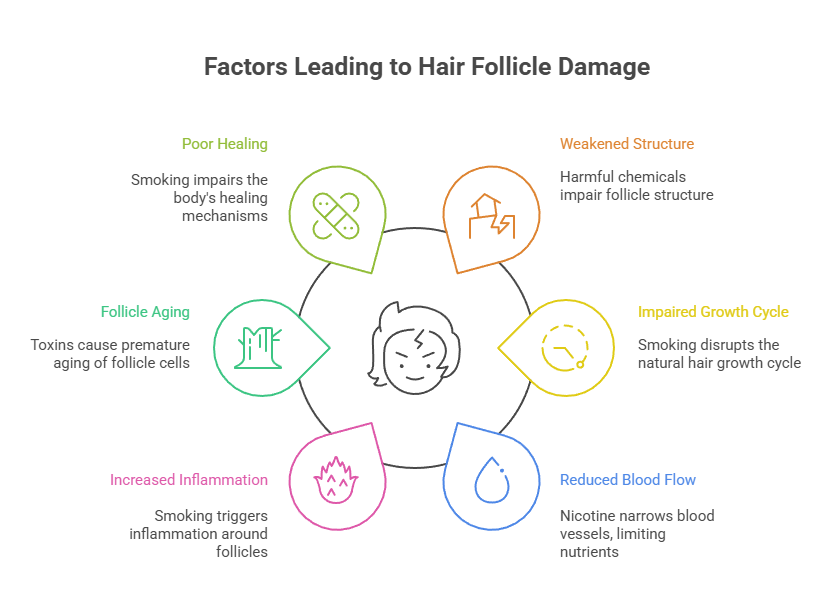
Early Onset Androgenetic Alopecia
One of the things that could occur when you smoke cigarettes regularly for a long time is early onset androgenetic alopecia.
It is the androgenetic hair loss that typically occurs before the age of 30. For males, androgenetic alopecia is generally referred to as male balding. Alternatively, androgenetic alopecia among females is typically referred to as female pattern hair loss or female pattern baldness.
While androgenetic alopecia is mainly hereditary, lifestyle choices like smoking can significantly influence how early and how severely it manifests. If you begin smoking at a young age, you will be vulnerable to it since cumulative exposure to tobacco toxins could intensify follicle damage over time.
In a study investigating hair issues and the connection to cigarette smoking, researchers from Egypt recruited a thousand healthy men aged 20 to 35, free from any local scalp conditions. They were then divided into 2 equal groups: people who smoked and people who did not smoke. In this population, the Trichoscopy and the Hamilton baldness scale were used to identify cases of such hair condition.
The study revealed that 425 participants who smoked developed a form of androgenetic alopecia as opposed to nonsmokers. In the group of smokers, approximately 47% of them had grade 3 androgenetic alopecia, while 24% of them had grade 4.
Researchers concluded that the nicotine and other chemicals from tobacco may possibly cause the acceleration of the progress of the disorder.
You see, smoking can truly accelerate hair loss as it can damage blood vessels, reduce scalp circulation, and increase the production of dihydrotestosterone, which is a hormone that can shrink hair follicles. Nicotine and other toxic compounds can then reduce oxygen supply and essential nutrients to the scalp, weakening hair follicles over time.
As follicles become miniaturized, they produce thinner and shorter hairs until they eventually stop producing healthy hair altogether.
Smoking can likewise increase oxidative stress and inflammation, both of which damage follicular cells and disrupt the normal cycle of hair growth. In genetically predisposed individuals, the impact of cigarette smoke on hormone levels such as cortisol and androgen can also lead to hair thinning.
Oxidative Stress and Hair Loss
When your body’s antioxidant defences are overwhelmed by free radicals, oxidative stress occurs, which can lead to cellular damage.
Cigarette smoke is a primary source of free radicals that can slowly harm your DNA, lipids, and proteins, including those found in your hair follicle cells. Over time, this damage can weaken the hair growth process, causing increased hair shedding or thinning.
Hair follicles are particularly susceptible to oxidative stress due to their rapid cell division and high metabolic activity. Constant exposure to free radical damage typically leads to premature senescence, a state where the follicles stop functioning optimally. This results in slower hair growth, finer strands, and in some cases, follicle death.
Smokers also have reduced levels of natural antioxidants like vitamins C and E, which makes it even more difficult for the body to neutralize harmful molecules. This imbalance leads to chronic inflammation, further impairing the scalp environment and accelerating hair loss. The scalp may also experience reduced healing capacity and become more prone to infection or irritation.
Smokers, based on numerous dermatological studies, typically possess higher levels of oxidative stress markers in both skin and hair samples. These findings support the notion that tobacco-related oxidative stress can contribute to hair thinning, particularly in individuals with pre-existing hair loss conditions.
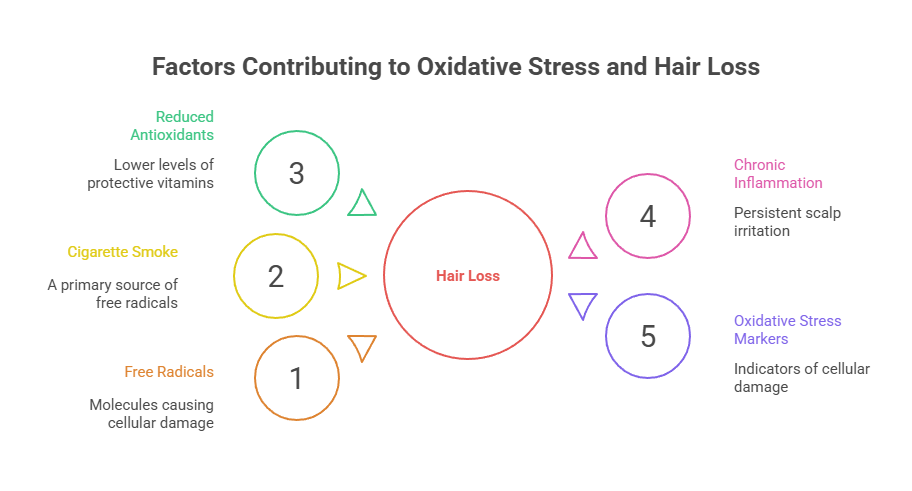
Hormonal Imbalances and Hair Loss
Cigarette smoking, for decades, has been linked to hormonal imbalances. Tobacco smoking can influence your levels of cortisol, estrogen, androgens, and insulin, all of which play vital roles in the hair growth cycle. These hormonal disruptions can shorten the growth or anagen phase and increase hair shedding, especially in individuals who are already predisposed to hair loss conditions.
Some hormones that could be affected by smoking cigarettes that lead to hair loss are:
- Dihydrotestosterone: One of the key hormones affected by smoking is dihydrotestosterone or DHT. It is a potent androgen that is linked to follicle miniaturization in androgenetic alopecia. Smoking may increase the production of DHT or enhance its sensitivity at the follicular level, which accelerates hair thinning and leads to androgenetic alopecia in both men and women.
- Estrogen: In women, smoking cigarettes may lower estrogen levels, which contributes to thinning hair and a shift toward more androgen-dominant hormonal profiles. The imbalance caused by smoking cigarettes can lead to female pattern hair loss, especially during menopause.
- Cortisol: Chronic stress caused by nicotine from cigarette smoking can also elevate the cortisol levels in the body. This disrupts the hair cycle, pushing more follicles into the resting or telogen phase. High cortisol levels may also trigger telogen effluvium, a form of diffuse hair shedding.
- Thyroid hormones: Smoking can influence thyroid function by increasing autoimmune activity or altering hormone metabolism, decreasing thyroid-stimulating hormone or TSH levels and potentially increasing the production of T3 while reducing T4 levels. Imbalances in thyroid hormones (T3 and T4) can then lead to hair thinning, and smoking cigarettes can further affect thyroid function and potentially worsen hair loss.
- Insulin: In both men and women, insulin resistance, which is linked to smoking, can alter the balance of insulin and IGF-1. These metabolic disruptions can impair hair follicle growth and hair growth cycle, which contributes to thinning or slowed regrow of hair.
Since hair follicles rely on a delicate hormonal balance for healthy functioning, any disruption caused by cigarette smoking can have a number of negative effects. The interplay between stress hormones, sex hormones, and metabolic hormones creates a cascade that affects follicle activity negatively, making smokers more susceptible to earlier and more severe hair loss.
Aside from quitting smoking, your hormonal imbalances should be addressed by considering a medical evaluation for hormone levels. Treatments like DHT blockers, hormone replacement therapy, or stress management can somehow correct the imbalance and potentially reverse some hair loss.
You can then switch to tobacco-free products if you still want to consume nicotine. Native Smokes 4 Less offers e-cigarettes, nicotine pouches, and other products that can give you solid nicotine hits without the dangers associated with smoking tobacco.
Smoking-Related Hair Loss Conditions
Smoking has been linked to a number of hair loss conditions. These conditions are typically linked to cigarette smoking’s impact on immunity, inflammation, and circulation.
Some smoking-related hair loss conditions that are common these days include:
- Androgenetic alopecia: Smoking can somehow increase your levels of DHT, the hormone that causes hair follicle miniaturization. It also restricts the blood flow to follicles, which makes the hair growth cycle less effective. In genetically predisposed individuals, this condition can lead to the faster progression of male or female pattern baldness.
- Telogen effluvium: Telogen effluvium occurs when a large number of hair follicles prematurely enter the resting phase due to stress or toxicity. Smoking-induced oxidative stress and nutritional deficiencies can typically trigger this temporary yet distressing form of hair loss.
- Alopecia areata: Another hair loss condition linked to smoking is alopecia areata, an autoimmune disorder where the immune system attacks hair follicles leading to patchy baldness. Although genetics and stress are primary factors, cigarette smoking is believed to worsen immune system dysregulation, acting as a trigger for flare-ups. Those with autoimmune tendencies may be more vulnerable to this type of hair loss than non-smokers.
- Cicatricial (scarring) alopecia: Chronic scalp inflammation due to tobacco toxins can likewise contribute to cicatricial (scarring) alopecia. This rare but severe condition is aggravated by poor scalp health and delayed wound healing, both common in smokers. Over time, scarring replaces follicle structures, leading to irreversible bald patches.
- Poor post-procedure recovery: Tobacco smokers may experience slower recovery or poorer outcomes from cosmetic procedures like hair transplantation or PRP therapy. This is due to their follicles being less healthy. The cumulative effect of vascular damage, oxidative stress, and immune dysfunction makes the scalp less resilient. In essence, smoking doesn’t just cause hair loss and hair damage; it also limits treatment effectiveness.
- Premature graying: Smoking can also damage melanin-producing cells due to oxidative stress and toxin exposure. This leads to the early loss of hair pigmentation or the existence of grey hair, often occurring alongside or before hair thinning.
Smoking can contribute to various forms of hair loss beyond genetic factors, often through mechanisms that involve inflammation, immune disruption, and follicular damage. Quitting smoking can, fortunately, prevent further progression and improve treatment outcomes for smoking-related hair loss conditions.
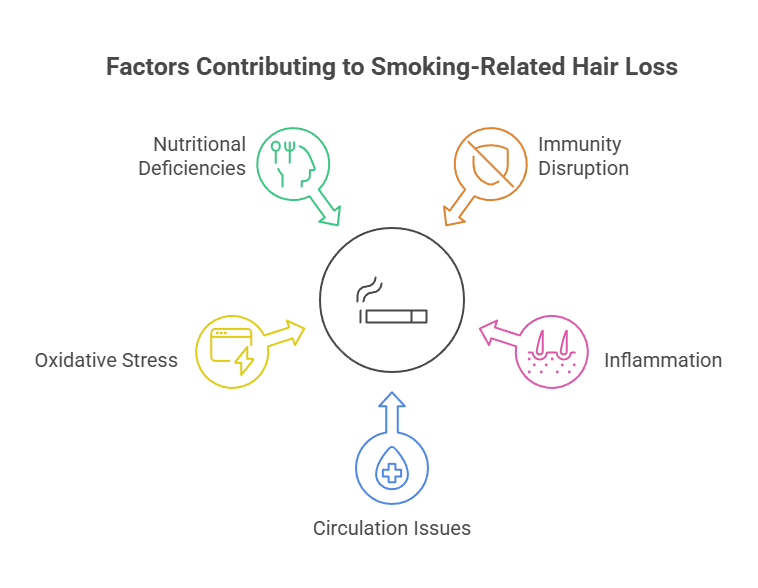
Quitting Smoking and Hair Regrowth
If there’s one thing you can do to somehow facilitate hair restoration and hair regrowth, that would be to stop smoking. Quitting smoking has been found to provide a profoundly positive impact on the overall health of your hair, potentially reversing some of the damage caused by prolonged tobacco use.
Although hair restoration and regrowth may not be immediate, many people report reduced shedding, improved hair texture, and healthier scalp conditions within a few months of smoking cessation. The body typically begins to repair itself soon after smoking stops, with circulation improving, oxygen levels rising, and inflammation decreasing, which can all support follicle recovery.
Smoking is known for restricting blood flow to your scalp. When you quit smoking, you can expect improved blood flow to the scalp, ensuring that hair follicles receive more oxygen and nutrients that are needed for promoting hair growth. Blood vessels, over time, can regain their natural function, creating a healthier environment that encourages dormant follicles to re-enter the growth phase.
Additionally, the decrease in oxidative stress after quitting smoking can reduce cellular damage in hair follicle cells. Once your antioxidant levels in the body have been stabilized, they can slowly repair DNA damage and support follicular activity, which helps the hair become shinier, stronger, and less brittle.
Hair regrowth after quitting smoking, nevertheless, still depends on a number of factors. They include the individual’s age, genetic predisposition, and how long they’ve smoked. While some hair loss may be reversible, severe damage to follicles may not fully recover. In such cases, medical treatments or prescription drugs may be needed to stimulate regrowth or prevent further loss.
Treatment Options for Hair Loss
When talking about hair loss, whether caused by smoking or other factors, various treatment options have become available to help slow, stop, or even reverse the process.
Some treatment options available for hair loss are as follows:
- Topical treatments: Topical treatments like minoxidil can be used to stimulate hair follicles and promote new growth. These over-the-counter medications are effective for both men and women, especially in the early stages of hair thinning.
- Oral medications: For those affected by androgenetic alopecia, prescription medications such as finasteride may be recommended. Finasteride works by blocking the enzyme that converts testosterone into DHT. While effective, this treatment is generally recommended for men, as it may not be safe for women, particularly during pregnancy.
- Platelet-rich plasma (PRP) therapy: PRP therapy involves injecting a concentration of a patient’s own platelets into the scalp to stimulate follicle repair and hair growth. This type of therapy can be used by those who are recovering from smoking-related follicular stress.
- Low-level laser therapy (LLLT): LLLT is another non-invasive option that uses red light to improve blood flow and energize hair follicles. This type of therapy can help stimulate hair regrowth and thicken hair over time with regular use.
- Hair transplant surgery: Hair transplants remain a viable solution for those with significant hair loss who have not responded to other treatments. In this surgical procedure, healthy follicles are taken from one area of the scalp and transplanted to thinning or bald regions. While expensive and time-consuming, transplants can produce natural-looking, long-lasting results.
Lifestyle changes can help support hair health. Quitting smoking, eating a balanced diet rich in vitamins and proteins, managing stress, and ensuring adequate sleep can complement the previously discussed medical treatments. It is also crucial to consult a dermatologist or trichologist to determine the best course of action as it is often tailored to individual needs and the underlying causes of hair loss.
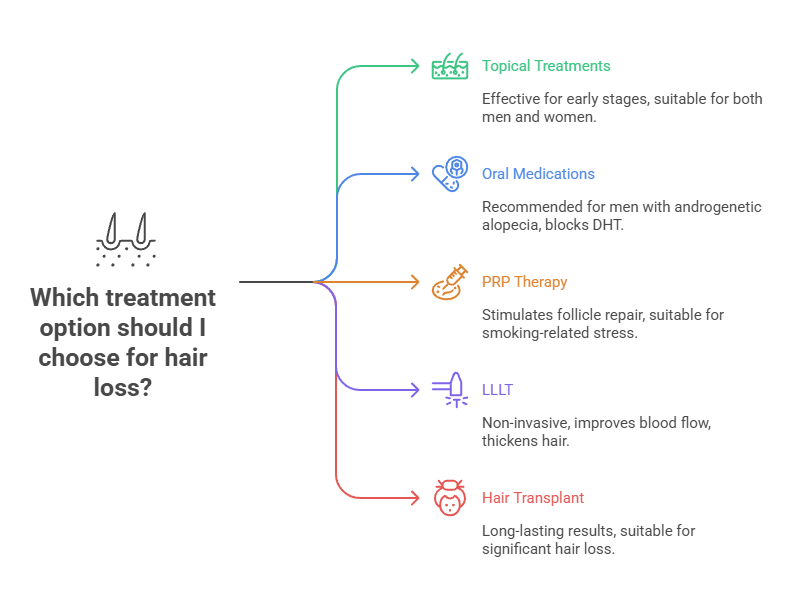
Preventing Hair Loss
Preventing hair loss begins with maintaining a healthy scalp and making lifestyle choices that protect and nourish your hair follicles.
One crucial step is to avoid smoking since tobacco use can contribute to reduced circulation, hormonal imbalances, and follicular damage. By quitting smoking, you safeguard your scalp environment and minimize the risk of premature thinning and baldness.
Nutrition also plays a vital role in hair health. A balanced diet rich in iron, biotin, zinc, vitamin D, and protein supports follicle function and promotes growth.
Managing stress is another key component in preventing hair loss. Chronic stress elevates cortisol levels, disrupting the hair cycle and pushing follicles into the resting phase. Mindfulness, regular exercise, and sufficient sleep can all help regulate stress hormones and support hair retention.
Avoiding tight hairstyles and harsh chemical treatments also reduces the risk of traction alopecia and damage to the hair shaft. Gentle grooming practices, which include the use of wide-tooth combs and sulphate-free shampoos, can preserve hair strength and minimize breakage. Scalp massages can further enhance blood flow and nourish follicles.
Regular check-ups with a healthcare provider or dermatologist are essential in catching early signs of hair thinning and addressing underlying causes such as hormonal imbalances or autoimmune conditions. By adopting a proactive approach, you can effectively protect your hair and reduce the risk of long-term hair loss.
Frequently Asked Questions
Will my hair grow back if I stop smoking?
Your hair may grow back if you stop smoking since doing so can significantly improve your scalp blood circulation and reduce oxidative stress. Take note, however, that hair regrowth and restoration may still depend on the extent of follicle damage and genetics. To support regrowth over time, you should take treatments like minoxidil or PRP therapy.
Does smoking increase DHT levels?
Yes, it does. Smoking cigarettes has been shown to influence hormone activity, including increasing dihydrotestosterone or DHT levels, particularly in men. Elevated DHT is a key factor in androgenetic alopecia or pattern baldness since it causes hair follicles to shrink.
Summary
Cigarettes, whether you like it or not, can cause hair loss when you smoke them regularly for a long time. Their nicotine content, as well as other harmful chemicals, can slowly affect the overall blood flow and oxygen supply to your scalp, leading to damaged hair follicles. Additionally, smoking can disrupt hormone levels, accelerating conditions like androgenetic alopecia. Smoking cigarettes can even impair nutrient absorption and collagen production, which are both crucial for healthy hair growth.
Over time, these effects of cigarette smoking can lead to noticeable hair thinning, premature greying, and in severe cases, permanent hair loss.
To prevent these things from happening, you should start your journey towards quitting smoking. Do you want to know how long it would take for you to quit cigarettes? Check this friendly guide from Native Smokes 4 Less about quitting cigarettes timeline.






















